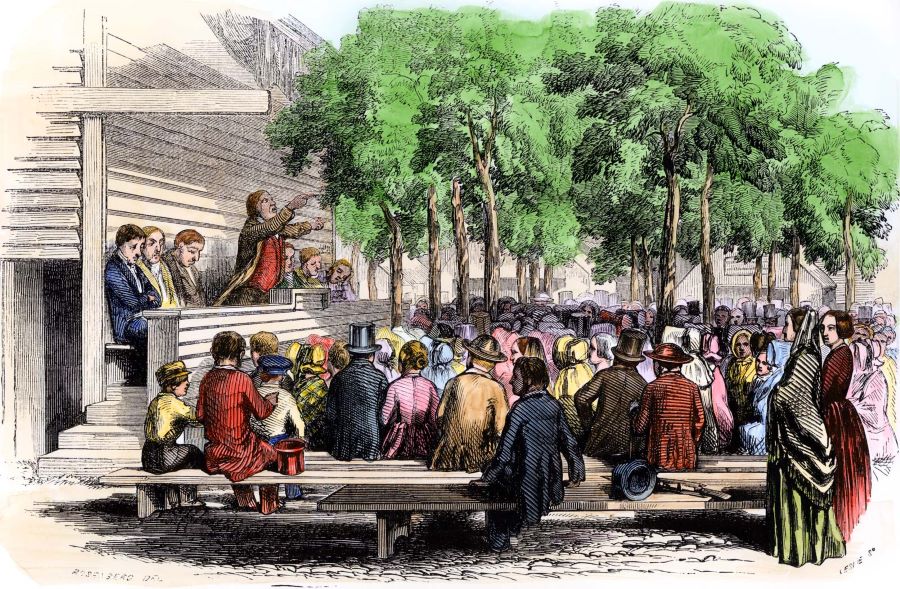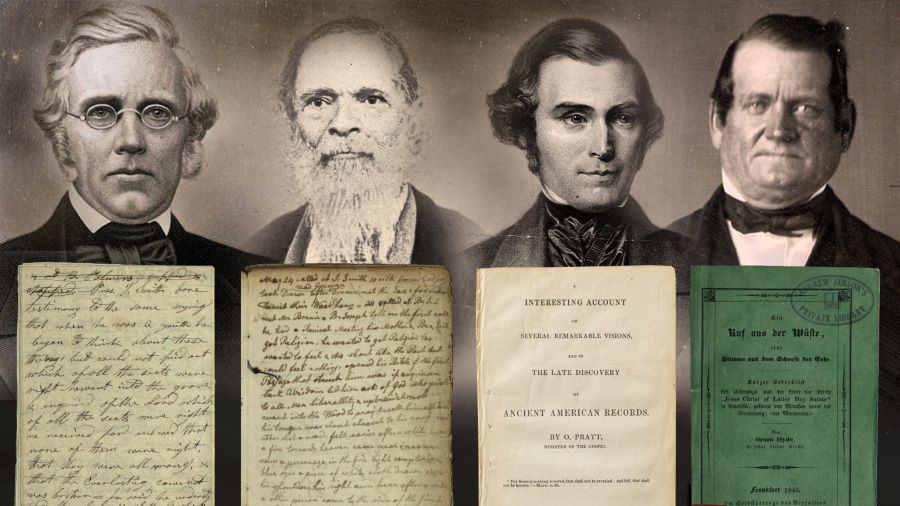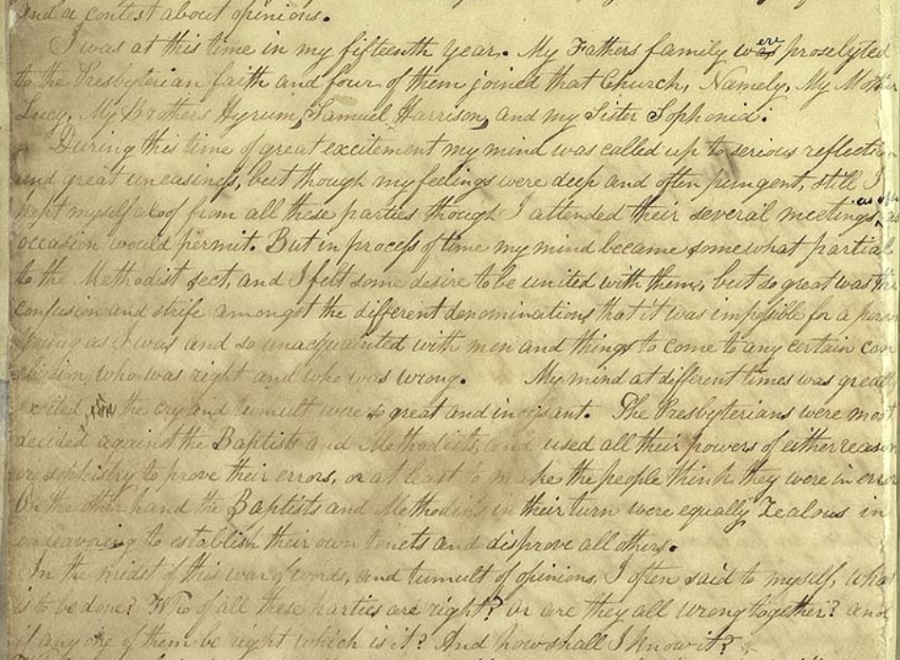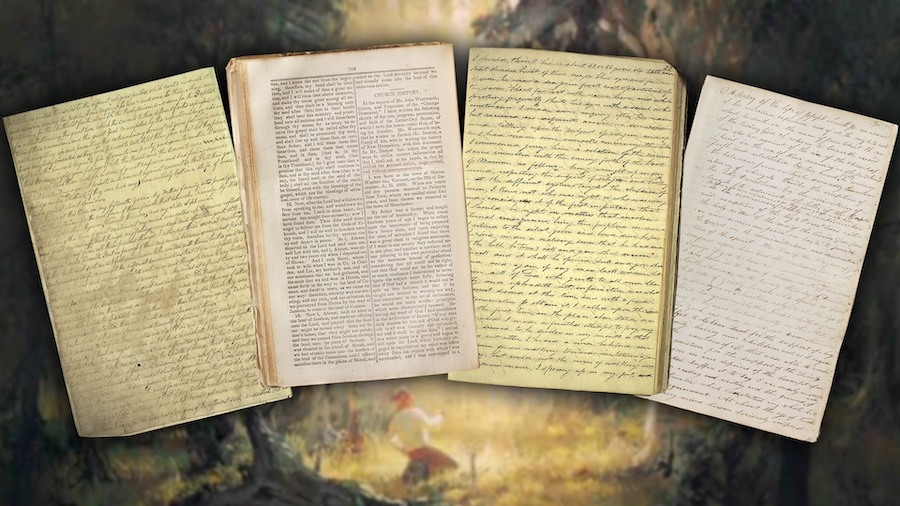Joseph Smith–History Insight #8
When Latter-day Saints tell the story of the First Vision today, they frequently emphasize Joseph Smith’s age when he entered the grove of trees near his family home to seek God in prayer. For instance, an article on the official website of The Church of Jesus Christ of Latter-day Saints states the following: “When Joseph Smith was 14 years old, he wanted to know which church he should join, so he asked God in sincere prayer. In response to this prayer, God the Father and His Son, Jesus Christ, appeared to Joseph and told him the true Church of Jesus Christ was not on the earth and They had chosen Joseph to restore it.”1 In another article published in the February 2020 issue of the Ensign, a magazine published by the Church, President Henry B. Eyring of the First Presidency recognized, “When 14-year-old Joseph Smith walked out of a grove of trees in Palmyra, New York, USA, he knew for himself that God communicates with His children in mortality.”2
Describing Joseph as fourteen years old when he experienced his First Vision comes from his 1838–39 history as canonized in the Pearl of Great Price. In that account Joseph described himself as “an obscure boy, only between fourteen and fifteen years of age” when he experienced his vision “early in the spring of eight hundred and twenty” (Joseph Smith–History 1:22–23, 14). A look at Joseph’s three other extant contemporary firsthand accounts of his First Vision reveals an overall consistency in this detail.
In his 1835 and 1842 accounts of the First Vision, Joseph identified himself as being, respectively, “about 14. years old” and “about fourteen years of age” when he experienced his vision.3 In another retelling, Joseph informed Erastus Holmes that he was “about 14 years old” when he received “the first visitation of Angels.”4
There is one exception, however. In Joseph’s earliest surviving account of his vision scribe Frederick G. Williams inserted interlineally that he was “in the 16th year of [his] age” when he called upon the Lord for forgiveness of his sins.5
The first point to keep in mind is that Joseph was consistent throughout his other accounts in placing his age at between fourteen and fifteen years old when he received his vision in the early spring of 1820. So too were the contemporary secondhand accounts of the First Vision recorded or published in Joseph’s lifetime, which all place him at that same age.6 What’s more, “in the 16th year of my age” does not necessarily mean Joseph was claiming he was sixteen years old when he had his vision, but could actually indicate that Joseph was no older than fifteen years old at the time of the vision. As historian D. Michael Quinn has observed, “like many people today, Joseph Jr. was confused by the distinction between stating his age . . . and its equivalent year-of-life.”7 The “16th year of [Joseph’s] age” would actually have started on his fifteenth birthday in December 1820,8 so while the dating of the vision in the 1832 account is still anomalous, it is not dramatically divergent from Joseph’s stated age of “about 14 years old” and “between fourteen and fifteen years of age” at the time of the vision in early 1820 in his later narratives.9
Looking at the 1832 history in fuller narrative context likewise helps make sense of this discrepancy.
Joseph Smith wrote that “at about the age of twelve years” his mind became concerned “with regard to the all importent concerns” of his immortal soul. He then became aggrieved that the various denominations did not “adorn their profession by a holy walk” as required by the Bible, and he pondered in his heart many things concerning the darkness of the world for three years, “from the age of twelve years to fifteen,” culminating with the vision in that year, as he says, when he was “in the 16th year of my age” (that is, fifteen years old). Here we learn that Joseph’s personal spiritual concerns began earlier (at the age of twelve) than we might otherwise have supposed and that his discontent over the contentions, divisions, wickedness, and abominations around him grew over a period of two to three years. It is understandable that, in preparing his 1832 draft, he might have thought of those intense struggles as having lasted a year longer than they actually had. After more careful reflection, he would consistently report that the answer came in his fifteenth year.10
Finally, as Matthew Brown has pointed out, by his own admission Joseph only had a rudimentary grasp of “the ground of Arithmatic.”11 When this point is brought into consideration, “it becomes apparent that the chronology changes that take place in Joseph Smith’s historical narrations originate not from an evolutionary scheme of storytelling but rather from a pronounced lack of mathematical skills” and perhaps simple lapses of memory in his first attempt to record his history.12 In other words, there is no reason to conclude that Joseph was fabricating the story of his First Vision simply because he innocently misremembered his age by less than a year in one of his accounts. And all of this, of course, assumes that Williams’ insertion of the phrase “in the 16th year of my age” in the 1832 history was at Joseph’s behest and was not an independent scribal interpolation.
The anomalous dating in the 1832 history notwithstanding, the cumulative historical evidence strongly favors the “traditional” date of early 1820 for the First Vision when Joseph was fourteen years old.
Source | Age of Joseph Smith at the Time of First Vision |
| JS History, ca. Summer 1832, pp. 1–3. | “<in the 16th year of my age>” |
| JS, Journal, 9–11 Nov. 1835, pp. 23–24 | “about 14. years old” |
| JS, Journal, 14 Nov. 1835, p. 37 | “about 14, years old” |
| JS History, 1838–1856, vol. A–1, pp. 2–3 | “in my fifteenth year,” “between fourteen and fifteen years of age,” “a little over fourteen years of age” |
| The Wentworth Letter (“Church History”) | “about fourteen years of age” |
| Orson Pratt, A[n] Interesting Account of Several Remarkable Visions | “somewhere about fourteen or fifteen years old” |
| Orson Hyde, Ein Ruf aus der Wüste | “his fifteenth year” |
| David Nye White, Interview with Joseph Smith, 21. August 1843 | “about fourteen years old, a mere boy” |
Further Reading
Steven C. Harper, First Vision: Memory and Mormon Origins (New York, NY: Oxford University Press, 2019), 9–44.
James B. Allen and John W. Welch, “Analysis of Joseph Smith’s Accounts of His First Vision,” in Opening the Heavens: Accounts of Divine Manifestation, 1820–1844, ed. John W. Welch, 2nd ed (Provo, UT: BYU Studies, 2017), 59–61.
Footnotes
1 See “The Testimony of the Prophet Joseph Smith” online at churchofjesuschrist.org
2 Henry B. Eyring, “The First Vision: A Pattern for Personal Revelation,” Ensign, February 2020, 13.
3 Journal, 1835–1836, 24; “Church History,” Times and Seasons 3, no. 9 (1 March 1842): 706.
4 Journal, 1835–1836, 37.
5 History, circa Summer 1832, 3.
6 Orson Pratt, A[n] Interesting Account of Several Remarkable Visions, [3], “When somewhere about fourteen or fifteen years old”; Orson Hyde, Ein Ruf aus der Wüste (A Cry out of the Wilderness), 13, “When he had reached his fifteenth year”; Interview, 21 August 1843, extract, [3], “He revealed himself to me first when I was about fourteen years old, a mere boy.”
7 D. Michael Quinn, Early Mormonism and the Magic World View, 2nd ed. (Salt Lake City, UT: Signature Books, 1998), 141.
8 Compare the language of the Universalist minister Sylvanus Cobb, who was born on July 17, 1798 and wrote of being converted in “the 16th year of [his] age” in “the autumn of 1813” when he was fifteen years old. Sylvanus Cobb, Jr., comp., The Autobiography of the First Forty-One Years of the Life of Sylvanus Cobb, D.D. (Boston: Universalist Publishing House, 1867), 23, 39; or the Reverend William Andrew Crocker, born on November 4, 1825, who wrote of his “formal profession of religion” in the “summer of 1841, in the 18th year of [his] age” when he was between sixteen and seventeen years old. John J. Lafferty, Sketches of the Virginia Conference, Methodist Episcopal Church, South (Richmond, VA: Christian Advocate Office, 1880), 37; or Dan Bradley, born on June 10, 1767, who “became a member of Yale College” in “September 1785” in “the 19th. year of [his] age” when he was eighteen years old. Israel Parsons, The Centennial History, of the Town of Marcellus, Delivered in the Presbyerian Church, of Marcellus, Onondaga County, N.Y. (Marcellus, NY: Reed’s Printing House, 1878), 36; or the poet Thomas Chatterton, born on November 20, 1752, who “in the summer of 1763, being then in the 12th year of [his] age, . . . contracted an intimacy with one Thomas Phillips” when he was eleven years old. The Poetical Works of Thomas Chatterton (Cambridge: W. P. Grant, 1842), 1:xvii, xxv. Additional examples could be multiplied (e.g. J. M. Russell, The History of Maidstone [Oxford: Oxford University Press, 1881], 392–393). It is also noteworthy that in the Book of Mormon the prophet-historian Mormon presented himself as being “fifteen years of age” (Mormon 1:15) at the commencement of his military career and yet in the next chapter, still in the same year, Mormon refers to himself as being “in [his] sixteenth year” (Mormon 2:1–2).
9 As Quinn, Early Mormonism and the Magic World View, 460n46, and Matthew B. Brown, A Pillar of Light: The History and Message of the First Vision (American Fork, UT: Covenant Communications, 2009), 99, point out, Joseph and other members of the Smith family sometimes experienced the same confusion (age vs. year-of-life) when it came to remembering other important dates, such as the age of Alvin Smith, Joseph’s older brother, at the time of his death.
10 James B. Allen and John W. Welch, “Analysis of Joseph Smith’s Accounts of His First Vision,” in Opening the Heavens: Accounts of Divine Manifestation, 1820–1844, ed. John W. Welch, 2nd ed (Provo, UT: BYU Studies, 2017), 60.
11 History, circa Summer 1832, 1.
12 Brown, A Pillar of Light, 99–101. On the role of memory in shaping Joseph’s accounts of the First Vision, see Steven C. Harper, First Vision: Memory and Mormon Origins (New York, NY: Oxford University Press, 2019), esp. 9–44.









